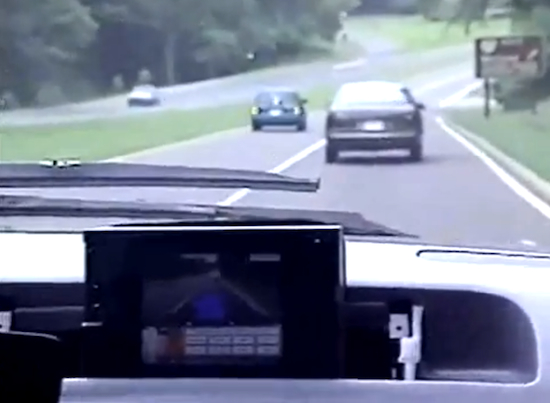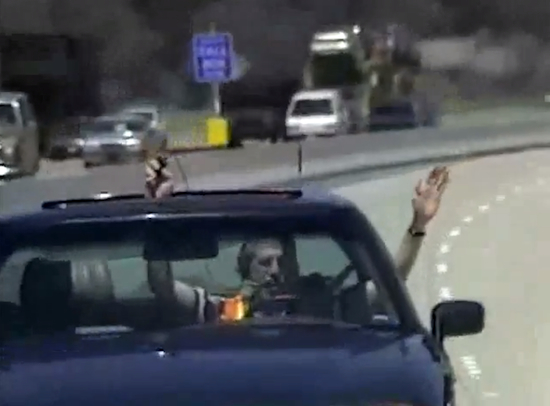The National Automated Highway System That Almost Was
In 1991, Congress authorized $650 million to develop the technology that would make driverless cars a reality
![]()

A computer visualization of the driverless car of the future (1997)
Visions of driverless cars zipping around on the highways of the future are nothing new. Visions of automated highways date back to at least the 1939 New York World’s Fair, and the push-button driverless car was a common dream depicted in such midcentury utopian artifacts as 1958′s Disneyland TV episode “Magic Highway, U.S.A.” But here in the 21st century there’s a growing sense that the driverless car might actually (fingers crossed, hope to die) be closer than we think. And thanks to the progress being made by companies like Google (not to mention just about every major car company), some even believe that driverless vehicles could become a mainstream reality within just five years.
Despite all the well-known sci-fi predictions of the 20th century (not to mention those of the 21st, like in the movies Minority Report and iRobot) many people forget the very earnest and expensive investment in this vision of the future from recent history. That investment was the multi-million dollar push by the U.S. Congress to build an automated highway system in the 1990s.
In 1991 Congress passed the Intermodal Surface Transportation Efficiency Act, which authorized $650 million to be spent over the course of the next six years on developing the technology that would be needed for driverless cars running on an automated highway. The vision was admittedly bold, seeing as how primitive all of the components needed for such a system were at that time. Even consumer GPS technology — which today we take for granted in our phones and vehicles — wasn’t a reality in the early 1990s.
The real-world benefits of automated highways were thought to be improving safety by removing human error from the equation, as well as improved travel times and better fuel economy.

Dashboard of an automated vehicle of the future (1997)
The National Automated Highway System Consortium was formed in late 1994 and were comprised of nine core organizations, both public and private: General Motors, Bechtel Corporation, The California Department of Transportation, Carnegie Mellon University, Delco Electronics, Hughes Electronics, Lockheed Martin, Parsons Brinckerhoff, and the University of California-Berkeley.
The goal was eventually to allow for fully automated operation of an automobile — what a Congressional report described as “hands-off, feet-off” driving.
The program was not without its detractors. In December of 1993 Marcia D. Lowe at the Worldwatch Institute wrote a scathing op-ed in the Washington Post. Perhaps unsurprisingly, Lowe mentions “The Jetsons.”
Computer-equipped cars driving themselves on automated highways. A scene out of “The Jetsons?” Not exactly.
Smart cars and highways have quietly emerged as the latest and most-expensive proposal to solve the nation’s traffic problems. Government spending on the little known Intelligent Vehicle and Highway Systems program is expected to exceed $40 billion over the next 20 years. (By comparison, in the first 10 years of the Strategic Defense Initiative, Washington spent $30 billion.)
Even more astonishing is the total lack of organized opposition to the idea, despite evidence that smart cars and highways may well exacerbate the very problems they are supposed to solve.

A demonstration of the automated highway system in San Diego (1997)
By 1997 the program had to show its technical feasibility in a demonstration in San Diego, California. On July 22 of that year the demonstration test vehicles rode down 7.6 miles of the HOV lane on Interstate 15. The Associated Press even reported that the prototype highway should be running by 2002.

A researcher demonstrates the driverless car by showing his hands aren’t on the wheel (1997)
During the lead up to the San Diego demonstration in 1997, the NAHSC produced a video called “Where The Research Meets The Road.” You can watch the video below.
Needless to say, the program didn’t deliver driverless cars and automated highways to Americans. So what was the problem? The legislation didn’t really give the Department of Transportation any direction on how they should go about the research—only that they needed to demonstrate it by 1997. But perhaps the biggest problem was that the legislation never clearly defined what was meant by “fully automated highway system.”
/https://tf-cmsv2-smithsonianmag-media.s3.amazonaws.com/accounts/headshot/matt-novak-240.jpg)
/https://tf-cmsv2-smithsonianmag-media.s3.amazonaws.com/accounts/headshot/matt-novak-240.jpg)